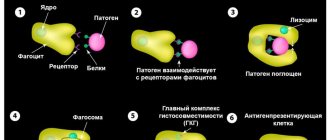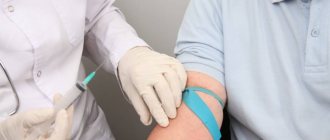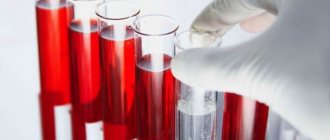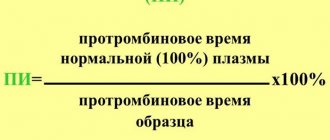Protein deficiency: what is it?
Now this problem is called a little differently - protein-energy deficiency (PEM).
This pathology is characterized by a low level of biologically active elements and energy, which negatively affects the functioning of the body's systems. Signs of PEM manifest themselves clearly:
- Rapid weight loss (up to 10%);
- Nervous system disorder;
- Dry skin and paleness.
To diagnose pathology, examination and laboratory tests are necessary. This will help assess the person's condition. Instrumental methods are necessary to identify the root cause of pathology.
Treatment includes high-protein and high-calorie enteral, tube or parenteral nutrition.
Causes
A common cause of pathology is a factor associated with socio-economic conditions. People's low income does not allow them to buy food with sufficient calories and vitamins. Living in regions where natural disasters often occur or military operations are taking place is also a reason for the occurrence of PEM in people.
Of course, the following diseases also contribute to the occurrence of PEM:
- Deficiency of biologically active elements (nutrients). This is caused by strict diets for gastroenterological and metabolic diseases, switching to parenteral nutrition, anorexia, and psychosis.
- Increased metabolic breakdown of cells and tissues (catabolism). The cause of this may be thyrotoxicosis, diabetes mellitus, and oncology.
- Digestive disorders. The most common causes of the disorder are chronic gastroenteritis, pancreatic steatorrhea, and bile dysfunction.
- Intoxication. The reasons are the use of potent drugs for a long time, polypharmacy, alcoholism.
- Alzheimer's and Parkinson's diseases. This is typical for older people.
In children, congenital causes are of primary importance in the structure of PEM:
- Developmental disorders;
- Neuromuscular pathologies;
- The problems are genetic.
Total protein and its norm (T-Prot)
Protein is present everywhere in the body and is represented by various components, each of which performs its own function
:
- The main “building” material for living cells;
- Participate in almost all biological reactions in the form of enzymes, carriers of inorganic compounds, catalysts;
- They represent a number of endocrine hormones (insulin);
- Takes direct part in the formation of a blood clot when the vascular wall is damaged;
- The full functioning of the immune system is ensured by immunoglobulins and antibodies - derivatives of amino acids;
- Needed to maintain blood viscosity, ensuring the best transfer of oxygen to tissues;
- Providing contraction of muscle fibers.
Modern laboratory diagnostics make it possible to study each protein fraction separately, but at the first stage it is necessary to determine the overall level - the mass of all protein molecules present in a unit volume of serum. This allows you to get an initial idea of the disorders of the corresponding metabolism and plan a further strategy for searching for pathology if it is present. Subsequently, large components are studied (albumin, globulins), then smaller and specific ones (fibrinogen, myoglobin, C-reactive protein, etc.).
Normal value
in biochemical analysis it is
62-86 grams per liter
. Being an important component of a living organism, this level is tightly regulated by various metabolic reactions, so deviations from the norm are more typical for severe conditions.
Slight fluctuations in concentration can be caused by certain medications, dietary habits and lifestyle. Such changes do not affect health, but in the longer term they lead to decreased immunity, endocrine and metabolic imbalance.
Toward decline
lead:
- Liver diseases (cirrhosis, hepatitis, parasitic lesions, poisoning, malignant lesions);
- Kidney diseases (glomerulonephritis, severe renal failure, in which the kidneys lose the ability to retain white compounds in the blood, and, on the contrary, excrete it in the urine);
- Primary immunodeficiencies (HIV);
- Common oncological processes;
- Metabolic disorders with inadequate treatment of diabetes mellitus, hypothyroidism, pancreatitis;
- Massive deep burns, chronic bleeding;
- Deterioration of absorption due to dysfunction of the gastrointestinal tract (enzymatic imbalance, gastric or duodenal ulcer);
- Deficiency in the diet (discrepancy between intake and needs);
- Pregnancy, especially in later stages and long-term lactation.
The need to determine T-Prot in the conditions listed above is beyond doubt. However, the indications for the study
There are also symptoms such as:
- Frequent cold infections;
- Presence of edema;
- Bleeding of gums, mucous membranes of the nose, mouth;
- Unmotivated weakness;
- Nausea, discomfort in the epigastrium and right hypochondrium;
- Lower back pain;
- Prolonged increase in body temperature to borderline subfebrile levels (37 - 37.5`C).
Exceeding normal values
is rare. However, this may indicate:
- Fluid loss (concentration of organic molecules with massive diarrhea, vomiting, polyuria, large-area superficial burns);
- The appearance of pathological fractions in allergic, autoimmune (lupus, rheumatoid diseases) and other systemic processes;
- Chronic severe infections (tuberculosis);
- Accelerated breakdown of red blood cells (hemolytic anemia due to severe poisoning, intoxication, after blood transfusions);
- Red bone marrow tumors and systemic tumors.
There are no specific symptoms of elevated protein. The clinical picture corresponds to the underlying disease. Therefore, if your health worsens, you need to undergo a biochemical analysis
of T - Prot
. This study is also performed annually as part of preventive examinations.
Risk factors
- Low standard of living;
- Vegetarian food;
- Following a mono-diet or fasting for the purpose of losing weight;
- Kidney diseases;
- Diseases of the digestive system;
- Hereditary factor;
- Occupation-related weight deficiency;
- Age 60+.
For children, the following risk factors should be considered:
- Prematurity;
- Intrauterine hyposkia;
- Use of alcoholic beverages and drugs by a pregnant woman.
Ascites in liver cirrhosis
Characteristics of the indicator
Total protein is an important component of protein metabolism in the body.
Protein is considered a building material that is simply necessary for all organs and systems of the human body. It, like a frame, forms the basis on which all cells and molecular structures of other types of metabolism are subsequently attached. In other words, protein is the main building material, without which it is simply impossible to restore the structure of cells and tissues.
Total serum protein is the concentration of albumin and globulin in the fluid component of blood. The building blocks of protein and protein functions are complex amino acids. Proteins are actively involved in various biochemical processes occurring in the human body. In addition, they serve to transport nutrients such as hormones, pigments, lipids and minerals.
Proteins are a kind of catalysts, and they are responsible for the immune function of the body.
Total protein helps maintain a constant pH environment in the blood circulating in the body and is actively involved in the coagulation system. Due to the presence of protein in the human body, all components of the blood are contained in the serum in a suspended state.
Based on the indicators of total protein, we can talk about the state of hemostasis, since thanks to this element the blood has such characteristics as fluidity and viscosity. Thanks to such qualitative characteristics of blood, the heart and the entire cardiovascular system as a whole work normally. Most often, in pathologies, the concentration of protein in the blood is reduced and this pathological condition is called hypoproteinemia.
Diagnostics and norms of the indicator
Blood sampling procedure to test total protein levels
Indications for determining blood protein are diagnostics:
- pathologies of the kidneys and liver
- repeated chronic infections
- burns and malignant neoplasms
- various specific pathologies
- diseases of the gastrointestinal tract
- malnutrition and varying degrees of malnutrition
- anemia and metabolic disorders
In addition, identification of total protein and its concentration is carried out as the 1st stage of preparation for a comprehensive health examination. Such a study may be prescribed in order to assess the body's reserves before undergoing surgery, various medical procedures and before taking medications.
In addition, the indication for determining total protein is the need to assess the effectiveness of the therapy and the prognosis of the current pathology.
Total protein standards:
- In newborns, the normal level of protein in the blood is considered to be 45-70 g/l.
- Over the next 15 years, this figure increases to a level of 60-80 g/l.
- In adult patients under 60 years of age, the level of this compound in the blood reaches 65-85 g/l.
- After 60 years, the indicator of such organic matter decreases to 62-81 g/l.
In some cases, a person may experience slight deviations from the norm downward, and this may occur under the influence of the following factors:
- severe dehydration
- breastfeeding period
- pregnancy
- Insufficient protein intake from food
- taking certain types of medications
- strong physical stress on the body
The level of protein in the human body can be determined using a biochemical analysis, which is carried out in the morning and always on an empty stomach. The last meal before the study should be no later than 8-12 hours. On the day of the test, it is recommended not to eat too much protein food, not drink a lot of fluids and avoid heavy physical activity on the body. The fact is that all these factors can affect the final result of the study in one direction or another.
Symptoms
If the protein deficiency is mild, then it does not manifest itself symptomatically, except in cases of hereditary deficiencies of certain amino acids, which are structural components of protein molecules.
External symptoms include:
- Continuous weight loss;
- Brittle nails;
- Brittle, dull and falling hair;
- Edema;
- Dryness, flaking of the skin;
- Weakness.
Nervous system symptoms:
- Migraine;
- Mood swings;
- Lethargy, fatigue;
- Sleep problems;
- Low mental activity.
Symptoms of the musculoskeletal system:
- Muscle weakness;
- Slow growth in children;
- Decreased muscle mass;
- Pain syndrome in muscles and joints.
Digestive organ symptoms:
- Nausea;
- Bloating, pain;
- Increased consumption of sweets;
- Problems with stool;
- Enlarged liver.
3.What can affect the content of total protein in the blood?
What can affect the level of total protein in the blood?
Reasons that may affect the content of total protein in the blood:
- Taking certain medications: corticosteroids, estrogens, androgens, growth hormones, or insulin;
- Injury or infection;
- Long bed rest;
- Chronic diseases, especially those that prevent you from eating certain foods;
- Pregnancy.
What's worth knowing?
If you have abnormal globulin levels, you may need additional testing for specific subgroups.
If the liver is damaged
and stops producing protein,
then the protein in the blood remains unchanged for some time.
Liver damage can be seen only after 2 weeks by analyzing the total level of protein in the blood.
Unlike carbohydrates and fats, proteins cannot be stored in the body. They are broken down into amino acids and used to form other proteins, hormones, enzymes and more.
Treatment
The minimum protein intake for an oncology patient should be at least one and a half grams per kilogram of body weight. For patients with renal failure - no more than 1.2 grams.
Since protein deficiency in a patient with cancer occurs due to inadequate intake or loss of proteins, for example, during the evacuation of water accumulations, it is impossible to reverse the pathological condition by increasing the volume of food.
In case of a loss of 5% of weight with an initial body mass index <20, a decrease in total plasma protein to 60 grams, globulin to 30 grams, and a balanced diet is impossible, it is urgent to start consuming specialized protein mixtures.
If the indicators are even worse or it is not possible to eat by mouth, tube or intravenous nutrition is necessary.
It is necessary to reduce the toxicity of treatment and symptomatic therapy. However, it is impossible to improve the quality of life and speed up the rehabilitation of a patient with cancer without high-quality nutritional support.
C-reactive protein test: what is it for?
What is C-reactive protein? What can a test result for this substance tell a doctor? What is the normal level of C-reactive protein in the blood? Nikita Valerievich Vorobyov, a neurologist at the Expert Clinic Kursk, answers these and other questions.
— Nikita Valerievich, before we talk about the analysis for C-reactive protein, please tell us what kind of substance this is? Is it present in the body normally or does it appear only during certain diseases? And what is the significance of the C-reactive protein test?
— C-reactive protein is a kind of indicator of various diseases, the most sensitive marker of the inflammatory process. With its help, the doctor can determine the severity of inflammation in the body. This substance is synthesized by liver cells in response to inflammatory processes in the body: during tissue damage, cell necrosis, during an infectious process, during exacerbation of chronic diseases, for example, rheumatological ones, including ankylosing spondylitis.
Being in the body within normal concentrations, C-reactive protein has a protective function: it initiates immune processes, stimulates phagocytosis (a process in which special blood cells and body tissues - phagocytes - capture and absorb various foreign structures, such as destroyed cells, bacteria, antigen-antibody complexes, etc.).
When the content of C-reactive protein in the blood begins to exceed the norm, this indicates some kind of inflammatory process, the nature of which the doctor will have to find out. Moreover, during acute inflammation, the content of C-reactive protein increases very quickly, literally in 6 hours. Much faster than, for example, ESR changes - the erythrocyte sedimentation rate.
When the treatment itself has already begun, an analysis for C-reactive protein helps the doctor understand what phase the pathology is in: is the acute period still ongoing or the disease has declined.
— What is the normal level of C-reactive protein in the blood?
- Depending on the laboratory, the norm of C-reactive protein varies from 0 to 1 milligram per liter and from 0 to 5 milligrams per liter. There is no lower limit of normal; this protein is detected in the blood only in response to acute inflammation. Within acceptable limits, the level of C-reactive protein can fluctuate during physical activity (for example, after playing sports), smoking, or eating fatty foods.
- Then, it turns out, there is no point in asking under what circumstances C-reactive protein can be lowered? Is this question not valid?
- Right. There are two options: either the protein is normal, or its content is increased. There can be no reduction.
— Why can C-reactive protein be elevated?
— I have already partially answered this question: its content increases with the appearance of inflammatory processes in the body. The reasons for the increase in C-reactive protein may be:
- previous trauma, burn;
- rheumatological disease;
- presence of infection;
- transplant rejection reaction.
The content of this protein also increases during myocardial infarction, after undergoing severe operations.
An analysis for C-reactive protein - I repeat, as an auxiliary study - is used if there is a risk of developing cardiovascular complications, in particular, when diagnosing atherosclerosis: with inflammation of the vascular walls, the concentration of this protein also increases.
— Tell me, how does C-reactive protein behave during pregnancy?
— Since pregnant women have a higher immune system tension than non-pregnant women and, even more so, than men, the content of C-reactive protein during this period may be increased. If the woman is healthy and gestation is normal, this indicator increases from the 16th to the 28th week of pregnancy, then gradually begins to decrease. Then it may increase immediately before childbirth. A high concentration of C-reactive protein in the blood may indicate a risk of developing late toxicosis.
— Which doctor and under what circumstances prescribes a test for C-reactive protein? What might be the reason for this research?
— A general practitioner, therapist, or neurologist can refer a patient for this analysis. But, since this type of research is primarily used in the diagnosis of rheumatological diseases, most often this direction is issued by a rheumatologist.
An analysis for C-reactive protein is carried out, for example, if ankylosing spondylitis is suspected. When making a diagnosis, this study plays an auxiliary role; it is used in conjunction with other markers. When ankylosing spondylitis has already been detected, the doctor can determine by the concentration of C-reactive protein what phase the disease is in - in the stage of exacerbation or remission (the period of weakening or disappearance of the symptoms of the disease).
This test is also prescribed for joint pain, increased body temperature, and infectious processes.
Neurologists use this type of analysis to understand the nature of a patient's back pain.
— Do you always need a referral from a doctor to get tested for C-reactive protein? And if not, what is more correct: to take it as directed or on your own initiative?
— Having a referral for such an analysis is not a prerequisite. But it is still better to do any research after consulting a doctor.
— Does the patient need to somehow prepare for the C-reactive protein test?
— The procedure is a simple blood draw from a vein. No special preparation is required from the patient. The generally accepted rules in such cases apply. The test is taken on an empty stomach, after a 12-14 hour fast (usually this is done in the morning). The day before, 24 hours before the test, you need to avoid drinking alcohol and intense physical activity. It may be necessary to temporarily stop taking certain medications, but only after consultation with your doctor.
1-2 hours before the test, you need to refrain from smoking, tea, coffee, and juices. You can drink still water. Running and quick climbing of stairs should be avoided. It is not recommended to do the study after emotional stress or severe anxiety.
— How long should I wait for the test result?
- Usually no more than one day.
Interviewed by Igor Chichinov
Want to learn more about other tests? Read articles in our “Laboratory Tests” section If you need to get tested for C-reactive protein or other tests, you can sign up here You can make an appointment with specialists here ATTENTION: services are not available in all cities
The editors recommend:
Pain with rheumatoid arthritis: how to help the patient? Are you worried about pain in your lower back? We're talking about sacroiliitis Are you crunchy? What will an MRI of joints tell you?
For reference:
Vorobiev Nikita Valerievich
Graduate of the Faculty of Medicine of Kursk State Medical University in 2021. In 2021, he completed his residency at Kursk State Medical University in the direction of Neurology. Advanced training: interventional methods of treatment in neurology, First Moscow State Medical University named after. THEM. Sechenova, 2021. Advanced training: local therapy of diseases of the musculoskeletal system and compression-neural syndromes, Kursk State Medical University, 2021. Currently, a neurologist at the Expert Clinic Kursk. Receives at the address: st. Karl Liebknecht, 7.
Why might total protein be reduced?
- Total protein falls due to the low intake of proteins in the body from food or due to impaired protein absorption in the gastrointestinal tract. A decrease in total protein is observed during periods of fasting, diets, and also with inflammatory bowel diseases.
- Another reason for a decrease in protein is liver disease, since it is this organ that produces most of the protein. Such diseases include hepatitis, cirrhosis, and liver atrophy.
- Kidney disease is another reason for low protein. The kidneys filter the body's waste products from the blood into the urine. If the kidneys are functioning properly, they will allow the protein to remain in the bloodstream. But if kidney function is impaired, protein will leak into the urine.
- Celiac disease is an autoimmune disease and another cause of low protein levels.
To determine the level of total protein in the blood and further understand the reasons for its decrease, you need to take a blood test for total protein.
A doctor of any specialization - therapist, gastroenterologist, gynecologist, etc. - has the right to prescribe a blood test for total protein.









